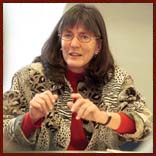|
|
|
Are math problems bugging your kids? Tell them to talk back -- using their hands. Psychologists at the University of Chicago report that gesturing can help kids add new and correct problem-solving strategies to their mathematical repertoires. What's more, when given later instruction, kids who are told to gesture are more likely to succeed on math problems. Researchers at the University of Chicago conducted two studies with a total of 176 children in late third and early fourth grade. Broaders and her colleagues randomly assigned the students to different manipulations -- told to gesture, told not to gesture, and not told anything either way (control). All participants had been found to make mistakes in solving math problems. |
- Susan Goldin-Meadow
|
In that study, the researchers assessed how gesture vs. no-gesture students performed after subsequent instruction in how to solve the math problems. At post-test, children who'd been told to gesture about math problems and then had a lesson solved 1.5 times more problems correctly as did the children who'd been told not to gesture -- a significant advantage. The authors conclude, "Telling children to gesture encourages them to convey previously unexpressed, implicit ideas, which in turn makes them receptive to instruction that leads to learning." Gesturing appears to help children to produce new problem-solving strategies, which in turn gets them ready to learn. The authors speculate that gesturing may help kids notice aspects of the math problems that may be more easily grasped through gestural representation. The findings extend previous research that body movement not only helps people to express things they may not be able to verbally articulate, but actually to think better. At the same time, gesturing offers a potentially powerful new way to augment the teaching of math. Strategies for math problems have focused on externalizing working memory, such as writing things down in certain ways. However, children often find it hard to recall and use those strategies. Gesturing may be more accessible, and help break through the roadblock. SOME OF THE RESULTS:
More results are published in the Scientific Article: "Making Children Gesture Brings Out Implicit Knowledge and Leads to Learning," Sara C. Broaders, PhD, Susan Wagner Cook, PhD, Zachary Mitchell, BA, and Susan Goldin-Meadow, PhD; University of Chicago; Journal of Experimental Psychology: General, Vol. 136, No. 4. "Are math problems bugging your kids? Tell them to talk back - using their hands" Related sources: Hand Gestures dramatically improve learning! Hand Gestures linked to better speaking Language might have evolved from Hand Gestures Hand Gestures control your TV Talk to the Hand Giving Science the Finger Double Digits Orthopaedic Hand news Healing by gentle touch reduces stress and pain |
|
COPYRIGHT © 2002-2014: Martijn van Mensvoort |